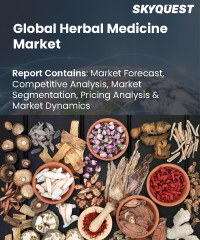
Product ID: SQMIG35B2103

Report ID:
SQMIG35B2103 |
Region:
Global |
Published Date: February, 2024
Pages:
242
|
Tables:
149 |
Figures:
78
Europe has the world's largest cosmetics market, which should provide good opportunities for new entrants from developing countries. Demand for natural ingredients used in personal care and beauty products is increasing at the same time, and this trend is expected to continue. Following this demand from European countries, Europe is expected to significantly contribute to market growth in the future. Turmeric is becoming increasingly popular in the European health-care market. Because of its antioxidant and anti-inflammatory properties, it is used as a supplement and in medical products to improve the immune and digestive systems, as well as overall health. The majority of turmeric imported into the EU comes from India, but other sources include Thailand, Madagascar, Peru, and Sri Lanka. The increasing lifespan of the European population is a major driver of turmeric demand. Rising health consciousness among the European population will drive regional growth. Turmeric is a popular spice in the region due to the prevalence of ethnic cuisine.
In North America, there is a growing awareness of health among consumers, particularly in the United States, and there is a shift in people's attitudes toward natural care products as a result of a powerful green wave. This is due to the perceived negative effects of alternative medicines on people's health. This has aided the product's success in the US market.
The cosmetics market in Asia Pacific and Latin America is also expanding rapidly. With increased internet usage, consumers are becoming more aware of the long-term benefits of herbal products and are eager to use natural and herbal products. Furthermore, rising disposable income in developing countries such as India, China, Brazil, and Southeast Asia has kept these markets growing. South Africa, the United Arab Emirates, Qatar, Saudi Arabia, Kenya, and Nigeria are among the developing countries in the Middle East and Africa region, as well as some of the world's major emerging economies. Families in these countries are expected to spend more on cosmetic products as their financial stability improves, and this factor is expected to play a significant role in market growth.
Our industry expert will work with you to provide you with customized data in a short amount of time.
REQUEST FREE CUSTOMIZATIONGlobal Herbal Medicine Market size was valued at USD 151.91 billion in 2019 and is poised to grow from USD 168.86 billion in 2023 to USD 437.59 billion by 2031, growing at a CAGR of 11.16% in the forecast period (2024-2031).
Want to customize this report? This report can be personalized according to your needs. Our analysts and industry experts will work directly with you to understand your requirements and provide you with customized data in a short amount of time. We offer $1000 worth of FREE customization at the time of purchase.

Product ID: SQMIG35B2103